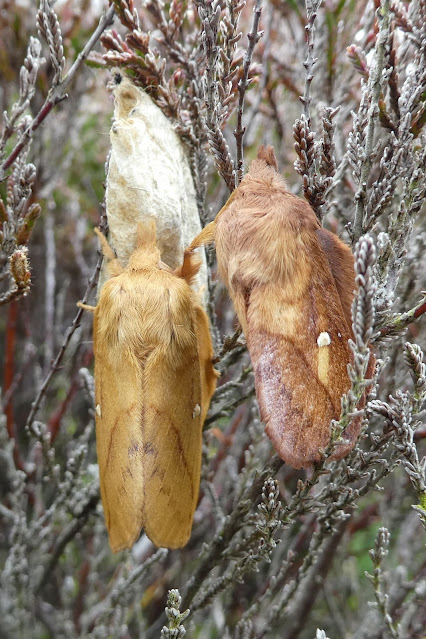We had planned a Sunday trip to Hoy, not work-related, not wildlife survey-related, just Megan and I losing ourselves in Nature. Because it was mid-June, the obvious hope was for dragonflies, but the temperature was barely into double figures Celsius, with low cloud, rain showers and a chilly northerly breeze.
As we drove off the ferry, most of the other passengers were either headed for the Scapa Flow Museum and its naval memorabilia or to Rackwick Bay and the scenic path to the Old Man of Hoy. This was our cue to take the quieter road in the opposite direction for a circumnavigation of South Walls, birding from the car whilst the weather did its worst. An hour and a picnic stop later, we finally headed back north with the bird list on 40 species and a pleasant Coronation Chicken aroma in the car.
Despite the meteorological evidence to the contrary, we thought we would have a look at the pools near to Rackwick, just in case any damselflies were braving the conditions. They weren't, but this triggered the hunt for still pockets of air where they might be loitering. A few sheltered spots did reveal some insects, but nothing odonatological. Indeed, one of our first finds was a moth which neither of us had ever seen before, a Clouded Border, a really pretty creature that, looking at the photo now, seems to depict two Rhinos pretending to be a Push-Me-Pull-You.
This became the pattern of the day: find a likely piece of habitat; hunker down to see what was there; take photos of stuff. A little way along a burnside path, we found some caterpillars of the Magpie Moth who, as is their wont, were chomping on the Heather.
By the side of the path, sheltered beneath some towering Bracken were numerous stands of Northern Marsh Orchids, at which your author spent an inordinate amount of time on hands and knees trying to capture a decent image.
The vegetation was drenched from all the rainfall, but at least the wild roses looked very photogenic, despite the subjects rarely being still due to the wind.
Returning to the car, I detoured a few metres into the undergrowth to check out a tiny pool, but still without any luck. However, as I dejectedly turned around to retrace my steps, there on a clump of Heather was a very unexpected sight, a pair of large brown moths and a cocoon. Now, in these parts, large brown moths tend to be Northern Eggars, a relative of the Oak Eggar further south, and these ones seemed to fit the bill.
At my surprised exclamation, Megan quickly made for the spot and we both took plenty of photos. Seeing one Eggar is always fantastic, two seemed very indulgent!
Next stop on our tour was Sandy Loch, actually a reservoir, but a favourite haunt of Bonxies, Common Sandpipers and the occasional Common Hawker dragonfly. If I said two out of three ain't bad, I think you will know what we saw. Also here was a confiding Curlew, a very drookit Northern Eggar caterpillar and some Moonwort, the most unfernlike fern in the Solar System.
All this scrabbling around at ground level was hungry work, so we visited a local cafe for (second) lunch, devouring mince and tatties and slurping hot beverages until, miracle of miracles, the sun came out! This actually presented us with a bit of a quandary. Should we try our luck at more sites, or return to Rackwick again? We chose the latter option, not least because we wondered what the moths would be up to. We needn't have worried, they hadn't moved a millimetre, but what was moving was my ID. Something made me dig a little deeper into online resources, which was very fortunate, as the moths weren't Northern Eggars, they were Drinkers. Now, we had seen caterpillars of this species on the Scottish mainland in recent years, but what we didn't know was that they are not so common in Orkney, which meant that this was quite a good find. Even better, there were damselflies on the wing, the sun's warmth having tempted them out of hiding, with half a dozen or so of Large Reds and Blue-tails. Megan also got in on the "returning from a pool" act, finding another, much drier, Northern Eggar caterpillar.
Last pool of the day was the big pond by the Scapa Flow Museum, where despite the sky clouding over, we found another 10 Blue-tailed Damselflies and watched a Ruby Tiger moth fluttering between the flag iris leaves like a shimmering russet water spirit. What a day. And to think that I've been nursing a cold for three weeks now, and nearly didn't go.












Just been reading about the Clouded Border moth, fairly evenly distributed over Britain apparently although I've never seen one - maybe because it flies at night! Good find 👏
ReplyDeleteI was only aware of its existence because a friend had posted a photo of one which landed in his garden a few weeks back. Bearing in mind the wonderful and wacky names of some moths, I am amazed the Clouded Border isn't called Two Rhinos.
Delete